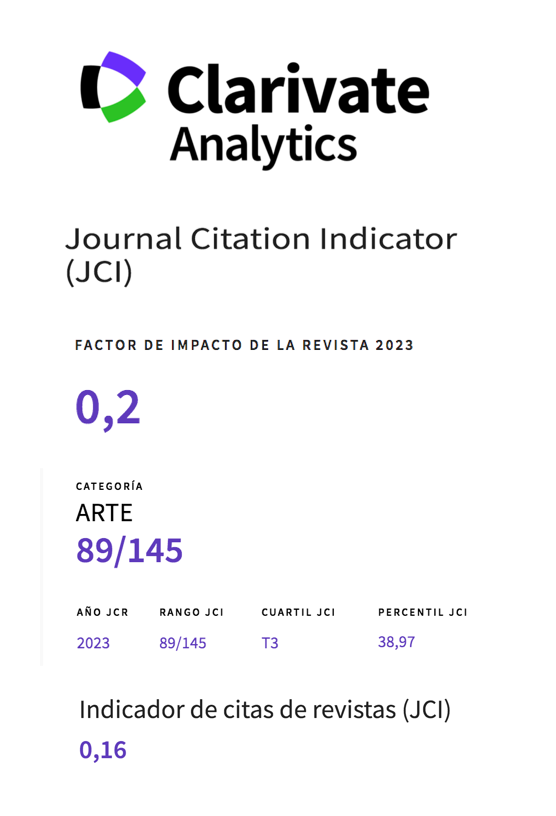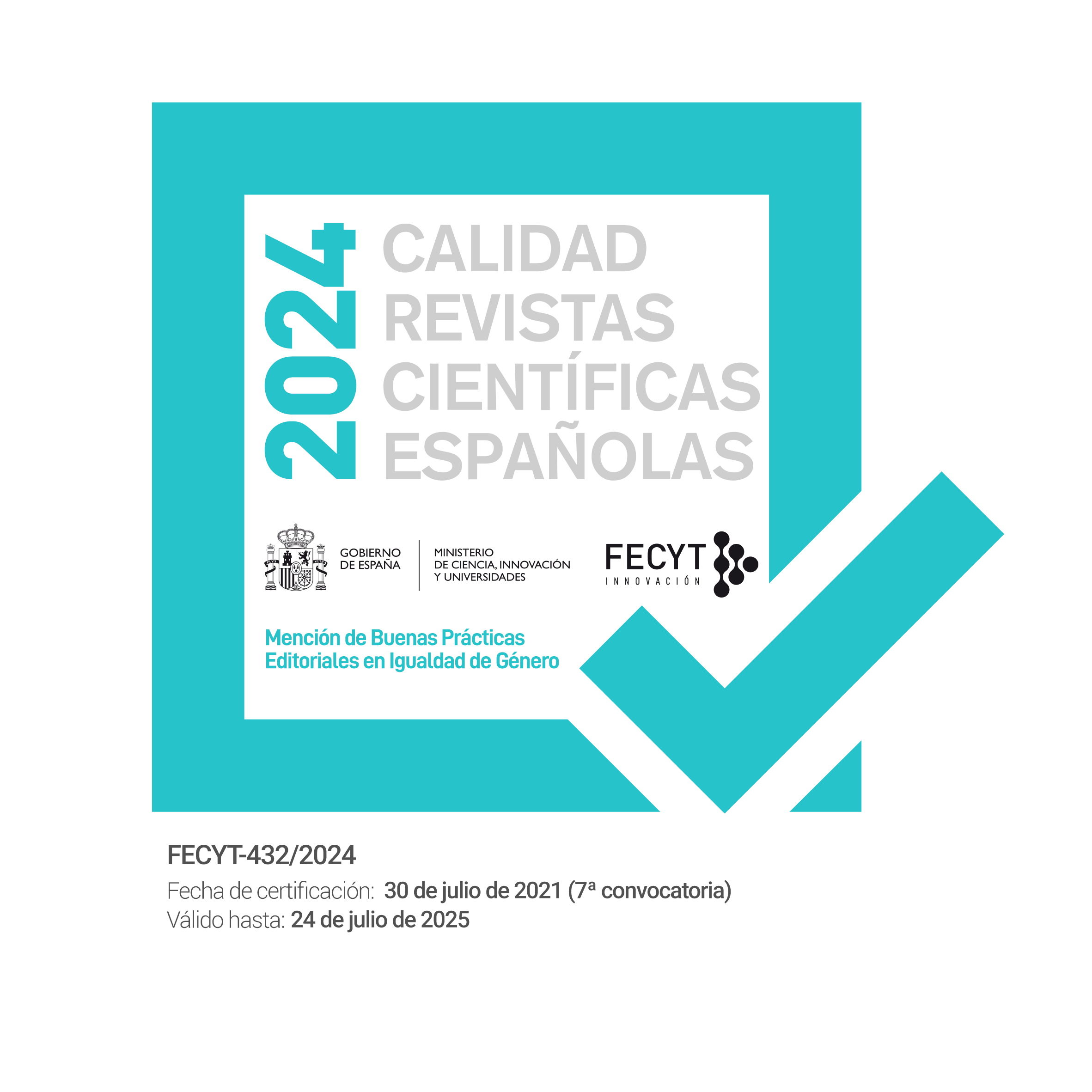El cine y su resonancia en el espacio: Una aproximación al cine expandido contemporáneo en España
Resumen
El desarrollo más importante de la última década en lo que respecta al cine experimental español ha sido el surgimiento y evolución de una serie de trabajos que, explorando las posibilidades de intervención directa en el acto de proyección, se posiciona en un territorio de herencia crítica con respecto al cine expandido. Este estudio investiga experiencias contemporáneas herederas del cine expandido contextualizándolas en relación a la problemática confluencia del cine experimental y el fenómeno de la desmaterialización del arte, así como su intricado establecimiento histórico en España.Descargas
-
Resumen2108
-
PDF666
Citas
Anker, S., Geritz, K., Seid. S. (Eds.) (2010). Radical Light, Alternative Film and Video in the San Francisco Bay Area, 1945–2000. Berkeley and LA: Univeristy of California Press
Aramburu, N., Trigueros, C. (Eds.) (2012). Caras B de la Historia del Video Arte en España. Madrid: Agencia Española de Cooperación Internacional.
Bonet, E. y Palacio, M. (1983). Práctica Fílmica y Vanguardia Artística en España, 1925-1981. Madrid: Universidad Complutense de Madrid
Collera, V. (13 julio 2013). Tacita Dean: pintora de la evanescencia (entrevista). El País.
Dean, T. (2011). Film (a book about film and the importance of analogue in the digital age). Cullinan, N. (Ed.) London: Tate Publishing
Deleuze, G. (1986). Cine, Cuerpo y Cerebro, Pensamiento. La Imagen-Tiempo, Barcelona: Paidós Comunicación, Barcelona.
Frampton, H. (2007). Notas Mentales. En George Stolz (ed), Especulaciones. Escritos sobre Cine y Fotografía. Barcelona: Museo de arte contemporáneo de Barcelona.
Hein, B. (2004). Interview with Gabriele Jutz.En Michalka, M. (Ed.), X-Screen. Film Installations and Actions in the 1960s and 1970s. Wien: Museum Moderner Kunst-Stiftung Ludwig/Köln: Walter König
Hein, B. (1979). Structural Film. En VVAA, Film as Film, Formal Experiment in Film 1910-1975. London: Hayward Gallery
Isou, I. (2005). La transformación isouana del cine. En Bonet, E. Y Escoffet, E., (Eds.) Próximamente en pantalla: el Cine Letrista, entre la Discrepancia y la Sublevación. Barcelona: Museo de Arte Contemporáneo de Barcelona.
Lee, Pamela M. (2003). Bare Lives.En Michalka, M. (Ed.), X-Screen. Film Installations and Actions in the 1960s and 1970s. Wien: Museum Moderner Kunst-Stiftung Ludwig.
Mekas, J. (1972). Movie Journal: The Rise of a New American Cinema, 1959-1971. New York: Collier
Michelson, A., (2000). Film and the Radical Aspiration. En P. Adams Sitney (Ed.), The Film Culture Reader. New York: Cooper Square Press
Païni, D. (2004), Should We Put an End to Projection?Trans. R. E. Krauss, October 110, 23-48
Palacio, M. (2002). ¿Qué será eso que llamamos la vanguardia cinematográfica?Alicante: Biblioteca Virtual Miguel de Cervantes.
Pérez, Pablo y Javier Hernández (1997) Maenza filmado en el campo de batalla, Departamento de Educación y Cultura, Zaragoza, 1997.
Pinent, A. (2008). Panorámica Sintética / Parcial del Cine Experimento en España desde la década de 1960 hasta la “última generación”. En Giannetti, C. (Ed.), El Discreto Encanto de la Tecnología. Artes en España. Badajoz: Junta de Extremadura.
Puig, L, (2007). Vicios (blog personal del autor). Universidad de Valencia,http://www.uv.es/puigl/vicios.htm
Renan, S. (1967). An Introduction to American Underground Film. New York: Dutton & Co.
Tucker, M. y Monte, J. (1969). Anti-Illusion: Procedures and Materials, New York: Whitney Museum of American Art.
VanDerBeek, S. (1966). Culture Intercom.Film Culture 40Val del Omar, José (2010). Escritos de Técnica, Poética y Mística, Ortiz-Echague, (Ed.), Barcelona/Madrid: Coup de Dés Ediciones de La Central/Museo Nacional Centro de Arte Reina Sofía
Walley, J. (2011). Identity Crisis: Experimental Film and Artistic Expansion. October 137, 23-50
Youngblood, G. (1970). Expanded Cinema. New York: Dutton & Co., Inc.
Works published in this journal are subject to the following terms:
- The Service of Publications from the University of Murcia (publishing house) keeps the published works’ copyrights, and favors and allows the reuse of these works under the license indicated in point 2.
- Works are published in the journal’s online edition under the license Creative Commons Reconocimiento-NoComercial-SinObraDerivada 3.0 España(texto legal). They can be copied, used, disseminated, transmitted and publicly exhibited, as long as: i) the author and original source of publication are cited (journal, publishing house and work’s URL); ii) they are not used for commercial purposes; iii) the existence and specifications of this license are mentioned.
3. Conditions for auto-file. It is allowed and encouraged that authors share electronically their pre-print version (the pre-reviewed version) and /or post-print version (the reviewed and accepted version) of their Works before the publication, since it promotes its circulation and dissemination. RoMEO color: green.









